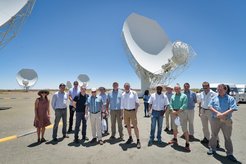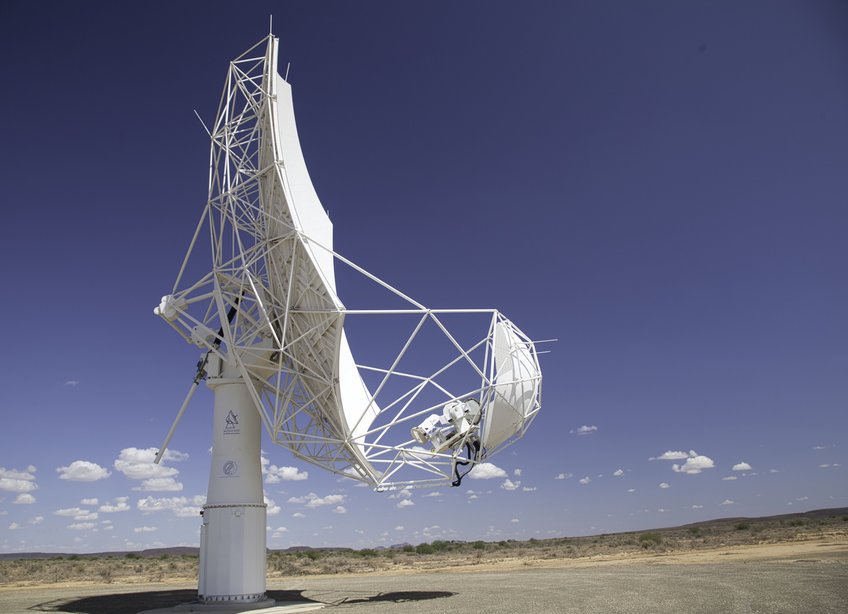The MeerKAT Extension Project
Improvement of the MeerKAT radio telescope array in South Africa by 20 additional dishes

The MeerKAT telescope array is a precursor facility for the worldwide project of a next-generation radio telescope, the Square Kilometre Array, and will eventually be integrated in the mid-frequency part of this international project.
The next generation of radio telescopes will enable vastly improved studies within a number of fields in radio astronomy. The observation of accurate pulsar clocks will provide a unique opportunity to find ripples in space-time. The tracking of young galaxies at high redshifts might help to identify the nature of mysterious dark energy. Maps of the three-dimensional distribution of cosmic magnetic fields will lead to the understanding of their impact in space. A look back into the Dark Ages, the time before the Universe lit up, provides opportunities to discover how black holes and stars were formed. The investigation of complex interstellar molecules may ultimately lead to building blocks of life in space.
The extension of the MeerKAT array means the start of a scientific and technological development initiated by a close collaboration between the South African Radio Astronomy Observatory (SARAO) and the Max-Planck-Gesellschaft (MPG). It will bring a legacy value to the international astronomical community ultimately leading to the Square Kilometre Array as the next-generation facility for radio astronomy.
This project is set to expand the baseline of the current radio telescope array by adding 20 additional dish antennas. The extension will be jointly funded by SARAO and MPG.
MeerKAT currently includes 64 dishes, and the extension project (MK+) will see this number rise to 84. Importantly, the extension will result in the maximum distance between the dishes increasing from 8 km to 17 km, a move that will increase both MeerKAT’s sensitivity and its ability to capture higher definition radio images. The telescope’s computing requirements will also increase tenfold following these improvements.
The South African partner will be responsible for establishing the site infrastructure, detectors and cryogenic infrastructure for the dishes, as well as data processing equipment whereas the German partner will provide the additional new dish antennas following the design of dishes for the Square Kilometre Array, instrumentation in the form of detectors, data acquisition and analysis systems for the MeerKAT telescope. Both partners will contribute R400 million (approx. 20 million €) each to the project.
German research institutions and industry have been an intrinsic part of the South Africa industrialisation programme, and have significant involvement in the ongoing design activities for the Square Kilometre Array. Within the dish engineering consortium, both are key players and together with international partners they are responsible for the designing of the mid-frequency antennas. In this spirit the Max-Planck-Gesellschaft has invested into the SKA-Max Planck Dish demonstrator, a dish antenna, which is currently being qualified by the South African team to the required specifications, at the South Africa’s Karoo region (see Fig. 1).
Dr Molapo Qhobela, Chief Executive Officer of the National Research Foundation of South Africa, said the extended MeerKAT would be an even more powerful telescope to study the formation and evolution of galaxies throughout the history of the universe. “The extended MeerKAT will increase the raw sensitivity of the instruments by about 50%, a move that will enable the telescope to survey the sky faster, and also enable it to detect even faintest astronomical sources.”
The MeerKAT extension project is closely associated with the infrastructure project for the mid-frequency part of the first phase of the Square Kilometre Array to be implemented in South Africa. Contractors working on the present extension project may be involved with the follow-on in future.
Thus the 20 additional dishes of the extension project will eventually be integrated into the first phase of the mid-frequency part of the Square Kilometre Array which will include a number of 197 dishes in total.
The project was initiated in 2019 with a thorough science evaluation and technical planning. Major tendering for the extension of MeerKAT is on its way and first installation activities on site are scheduled for middle of 2021. The further steps of integration and science commissioning are expected to commence in 2023.
"I am impressed what has been achieved with the MeerKAT telescope and we are proud to collaborate with our South African colleagues in the extension of the project”, concludes Prof. Martin Stratmann, the president of the Max-Planck-Gesellschaft in Germany who visited the Karoo site in South Africa in January 2020 (see Fig. 2). “You really have to see the facility directly – it is an impressive sight.“

--------------------------------
Background Information
The South African Radio Astronomy Observatory (SARAO), a facility of the National Research Foundation, is responsible for managing all radio astronomy initiatives and facilities in South Africa, including the MeerKAT Radio Telescope in the Karoo, and the Geodesy and VLBI activities at the HartRAO facility. SARAO also coordinates the African Very Long Baseline Interferometry Network (AVN) for the eight SKA partner countries in Africa, as well as South Africa’s contribution to the infrastructure and engineering planning for the Square Kilometre Array Radio Telescope (SKA). (https://www.sarao.ac.za/)
The Max Planck Gesellschaft (MPG) is a non-profit organisation with 86 institutes and research facilities. Among the society’s institutes is the Max Planck Institute for Radio Astronomy (MPIfR) as a key player in the SKA’s Dish engineering consortium. Together with German industry partners, such as the telescope antenna specialists MT Mechatronics (MTM), and international partners, the Dish consortium is responsible for designing the SKA’s mid-frequency array (SKA-Mid). The MPIfR and MPG have already invested 16 million Euros into MeerKAT earlier in partnership with SARAO to provide a complete state-of-the-art receiver system for MeerKAT with a so-called beamformer and a high performance computer system to detect radio pulsars and transients as well as in the SKA-DISH demonstrator. (https://www.mpifr-bonn.mpg.de)
The Square Kilometre Array (SKA) project is an international effort to build the world’s largest radio telescope, with a square kilometre (one million square metres) of collecting area. The SKA telescope will be co-located in Africa and in Australia. It will have an unprecedented scope in observations, exceeding the image resolution quality of the Hubble Space Telescope by a factor of 50 times, whilst also having the ability to image huge areas of sky in parallel. (https://www.sarao.ac.za/)
MeerKAT in the Karoo semidesert area in South Africa is a radio telescope array consisting of currently 64 dishes of 13.5 m diameter each. The name for the project was derived from the earlier Karoo Array Telescope (KAT). With more and more dishes added that led to “meer KAT” which also denominates the well-known Meerkat mammal living in this part of South Africa. The combined power of the single radio antennas forming a giant radio telescope network with a maximum virtual size of 8 km has already achieved impressive results – a radio map of the Galactic centre area published in 2019 gave a nice example. The MeerKAT extension project (MK+) will rise the number of antennas to 84 and increase the maximum distance between the dishes increasing from 8 km to 17 km. MeerKAT is the precursor for the SKA midphase array and will eventually be integrated in its final stage of 197 dish antennas at a later stage.

